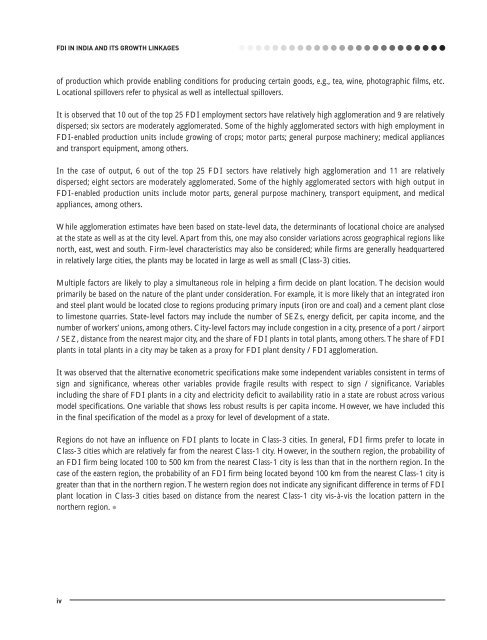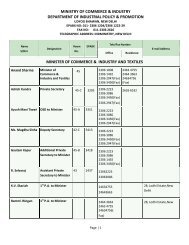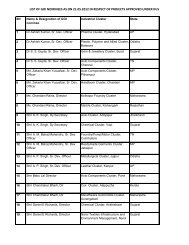fdi in india and its growth linkages - Department Of Industrial Policy ...
fdi in india and its growth linkages - Department Of Industrial Policy ...
fdi in india and its growth linkages - Department Of Industrial Policy ...
You also want an ePaper? Increase the reach of your titles
YUMPU automatically turns print PDFs into web optimized ePapers that Google loves.
FDI IN INDIA AND ITS GROWTH LINKAGES<br />
of production which provide enabl<strong>in</strong>g conditions for produc<strong>in</strong>g certa<strong>in</strong> goods, e.g., tea, w<strong>in</strong>e, photographic films, etc.<br />
Locational spillovers refer to physical as well as <strong>in</strong>tellectual spillovers.<br />
It is observed that 10 out of the top 25 FDI employment sectors have relatively high agglomeration <strong>and</strong> 9 are relatively<br />
dispersed; six sectors are moderately agglomerated. Some of the highly agglomerated sectors with high employment <strong>in</strong><br />
FDI-enabled production un<strong>its</strong> <strong>in</strong>clude grow<strong>in</strong>g of crops; motor parts; general purpose mach<strong>in</strong>ery; medical appliances<br />
<strong>and</strong> transport equipment, among others.<br />
In the case of output, 6 out of the top 25 FDI sectors have relatively high agglomeration <strong>and</strong> 11 are relatively<br />
dispersed; eight sectors are moderately agglomerated. Some of the highly agglomerated sectors with high output <strong>in</strong><br />
FDI-enabled production un<strong>its</strong> <strong>in</strong>clude motor parts, general purpose mach<strong>in</strong>ery, transport equipment, <strong>and</strong> medical<br />
appliances, among others.<br />
While agglomeration estimates have been based on state-level data, the determ<strong>in</strong>ants of locational choice are analysed<br />
at the state as well as at the city level. Apart from this, one may also consider variations across geographical regions like<br />
north, east, west <strong>and</strong> south. Firm-level characteristics may also be considered; while firms are generally headquartered<br />
<strong>in</strong> relatively large cities, the plants may be located <strong>in</strong> large as well as small (Class-3) cities.<br />
Multiple factors are likely to play a simultaneous role <strong>in</strong> help<strong>in</strong>g a firm decide on plant location. The decision would<br />
primarily be based on the nature of the plant under consideration. For example, it is more likely that an <strong>in</strong>tegrated iron<br />
<strong>and</strong> steel plant would be located close to regions produc<strong>in</strong>g primary <strong>in</strong>puts (iron ore <strong>and</strong> coal) <strong>and</strong> a cement plant close<br />
to limestone quarries. State-level factors may <strong>in</strong>clude the number of SEZs, energy deficit, per capita <strong>in</strong>come, <strong>and</strong> the<br />
number of workers’ unions, among others. City-level factors may <strong>in</strong>clude congestion <strong>in</strong> a city, presence of a port / airport<br />
/ SEZ, distance from the nearest major city, <strong>and</strong> the share of FDI plants <strong>in</strong> total plants, among others. The share of FDI<br />
plants <strong>in</strong> total plants <strong>in</strong> a city may be taken as a proxy for FDI plant density / FDI agglomeration.<br />
It was observed that the alternative econometric specifications make some <strong>in</strong>dependent variables consistent <strong>in</strong> terms of<br />
sign <strong>and</strong> significance, whereas other variables provide fragile results with respect to sign / significance. Variables<br />
<strong>in</strong>clud<strong>in</strong>g the share of FDI plants <strong>in</strong> a city <strong>and</strong> electricity deficit to availability ratio <strong>in</strong> a state are robust across various<br />
model specifications. One variable that shows less robust results is per capita <strong>in</strong>come. However, we have <strong>in</strong>cluded this<br />
<strong>in</strong> the f<strong>in</strong>al specification of the model as a proxy for level of development of a state.<br />
Regions do not have an <strong>in</strong>fluence on FDI plants to locate <strong>in</strong> Class-3 cities. In general, FDI firms prefer to locate <strong>in</strong><br />
Class-3 cities which are relatively far from the nearest Class-1 city. However, <strong>in</strong> the southern region, the probability of<br />
an FDI firm be<strong>in</strong>g located 100 to 500 km from the nearest Class-1 city is less than that <strong>in</strong> the northern region. In the<br />
case of the eastern region, the probability of an FDI firm be<strong>in</strong>g located beyond 100 km from the nearest Class-1 city is<br />
greater than that <strong>in</strong> the northern region. The western region does not <strong>in</strong>dicate any significant difference <strong>in</strong> terms of FDI<br />
plant location <strong>in</strong> Class-3 cities based on distance from the nearest Class-1 city vis-à-vis the location pattern <strong>in</strong> the<br />
northern region. �<br />
iv












